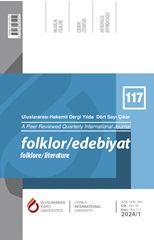Vahîd Mahtûmî’nin Lâlezâr (Yenişehr-i Fenâr) Şehrengizinde Atmosferin İnşâsı
Construction of the Atmosphere in Vahîd Mahtûm î's Shehrengiz Named Lâlezâr (Yenişehr-i Fenâr)
Author(s): Aslı AytaçSubject(s): Cultural history, Studies of Literature, Turkish Literature, 18th Century
Published by: Uluslararası Kıbrıs Üniversitesi
Keywords: Vahîd Mahtûmî; Lâlezâr; Yenişehir; shehrengiz; atmosphere;
Summary/Abstract: Shehrengiz can be defined as a poetic genre that presents the beauties of a neighborhood, who are famous in various arts and professions, with the elements of social life and local beauties of that neighborhood, with vivid descriptions and colorful praises. Shehrengiz texts have an important place in terms of not only recording the famous tradesmen, but also shedding light on the socio-cultural structure of the period they belong to, containing information about social and economic life, and reflecting features of daily spoken language. When evaluated together with the poet’s style, shehrengiz works should be considered as socio-cultural keys that involve many clues in the context of the structure of the society and the historical texture of the place or places in question. In Turkish literature, the shehrengiz type, which was mostly written in masnavi verse, began giving examples at the beginning of the 16th century and continued until the late 18th century. The text, which is the subject of the study, is the Lâlezâr (Yenişehr-i Fenâr) shehrengiz consisting of 524 couplets, in which Vahîd Mahtûmî, one of the 18th century poets, describes the characteristics of the city of Yenişehir, which is located in the borders of Greece today. Based on the text written in the form of masnavi, the places where the poet gave place to his description and the atmosphere created from these places were evaluated and the literary features of the expression were emphasized. The aim of the study is to illuminate the image of the city in the period and to reveal the effects of the places whose atmosphere is reflected on the mood of the people and social life by reading the characteristics of the places mentioned from the style of Mahtûmî, who successfully reflected the folk language and daily life conditions into poetry in the 18th century.
Journal: Folklor/Edebiyat
- Issue Year: 30/2024
- Issue No: 117
- Page Range: 273-292
- Page Count: 20
- Language: Turkish

